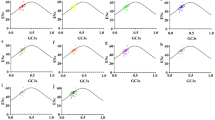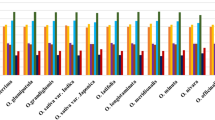Abstract
In the plant chloroplast genome the codon usage of the highly expressed psbA gene is unique and is adapted to the tRNA population, probably due to selection for translation efficiency. In this study the role of selection on codon usage in each of the fully sequenced chloroplast genomes, in addition to Chlamydomonas re-inhardtii, is investigated by measuring adaptation to this pattern of codon usage. A method is developed which tests selection on each gene individually by constructing sequences with the same amino acid composition as the gene and randomly assigning codons based on the nucleotide composition of noncoding regions of that genome. The codon bias of the actual gene is then compared to a distribution of random sequences. The data indicate that within the algae selection is strong in Cy-anophora paradoxa, affecting a majority of genes, of intermediate intensity in Odontella sinensis, and weaker in Porphyra purpurea and Euglena gracilis. In the plants, selection is found to be quite weak in Pinus thun-bergii and the angiosperms but there is evidence that an intermediate level of selection exists in the liverwort Marchanda polymorpha. The role of selection is then further investigated in two comparative studies. It is shown that average relative codon bias is correlated with expression level and that, despite saturation levels of substitution, there is a strong correlation among the algae genomes in the degree of codon bias of homologous genes. All of these data indicate that selection for translation efficiency plays a significant role in determining the codon bias of chloroplast genes but that it acts with different intensities in different lineages. In general it is stronger in the algae than the higher plants, but within the algae Euglena is found to have several unusual features which are noted. The factors that might be responsible for this variation in intensity among the various genomes are discussed.
Similar content being viewed by others
References
Bernardi G, Bernardi G (1986) Compositional constraints and genome evolution. J Mol Evol 24:1–11
Hallick RB, Bairoch A (1994) Proposals for the naming of chloroplast genes. III. Nomenclature for open reading frames encoded in chloroplast genomes. Plant Mol Biol Reptr 12:S29–30
Hallick RB, Hong L, Drager RG, Favreau MR, Montfort A, Orsat B, Spielman A, Stutz E (1993) Complete sequence of Euglena gracilis chloroplast DNA. Nucleic Acids Res 21:3537–3544
Ikemura T (1985) Codon usage and tRNA content in unicellular and multicellular organisms. Mol Biol Evol 2:13–35
Karlin S, Mrazek J (1996) What drives codon choice in human genes? J Mol Biol 262:459–472
Klein RR, Mullet JE (1986) Regulation of chloroplast-encoded chlorophyll-binding protein translation during higher plant chloroplast biogenesis. J Biol Chem 261:11138–11145
Kowallik KV, Stoebe B, Schaffran I, Freier U (1995) The chloroplast genome of a chlorophyll a+c-containing alga, Odontella sinensis. Plant Mol Biol Reptr 13:336–342
Lake JA (1985) Evolving ribosome structure: domains in archaebacte-ria, eubacteria, eocytes and eukaryotes. Annu Rev Biochem 54: 507–530
Li WH (1987) Models of nearly neutral mutations with particular implications for nonrandom usage of synonymous codons. J Mol Evol 24:337–345
Lobry JR, Gautier C (1994) Hydrophobicity, expressivity and aroma-ticity are the major trends of amino-acid usage in 999 Escherichia coli chromosome-encoded genes. Nucleic Acids Res 22:3174–3180
Lockhart PJ, Penny D, Hendy MD, Howe CJ, Beanland TJ, Larkum AWD (1992) Controversy on chloroplast origins. FEBS Lett 301: 127–131
Long M, Gillespie JH (1991) Codon usage divergence of homologous vertebrate genes and codon usage clock. J Mol Evol 32:6–15
Morton BR (1993) Chloroplast DNA codon use: evidence for selection at the psbA locus based on tRNA availability. J Mol Evol 37:273–280
Morton BR (1994) Codon use and the rate of divergence of land plant chloroplast genes. Mol Biol Evol 11:231–238
Morton BR (1996) Selection on the codon bias of Chlamydomonas reinhardtii chloroplast genes and the plant psbA gene. J Mol Evol 43:28–31
Morton BR (1997) Rates of synonymous substitution do not indicate selective constraints on the codon use of the plant psbA gene. Mol Biol Evol 14:412–419
Morton BR, Levin JA (1997) The atypical codon use of the plant psbA gene may be the remnant of an ancestral bias. Proc Natl Acad Sci USA 94:11434–11438
Mullet JE, Klein RR (1987) Transcription and RNA stability are important determinants of higher plant chloroplast RNA levels. EMBO J 6:1571–1579
Reith M (1995) Molecular biology of rhodophyte and chromophyte plastids. Annu Rev Plant Physiol Plant Mol Biol 46:549–575
Reith M, Munholland J (1995) Complete nucleotide sequence of the Porphyra purpurea chloroplast genome. Plant Mol Biol Reptr 13: 333–335
Sharp PM, Li W-H (1987a) The rate of synonymous substitution in enterobacterial genes is inversely related to codon usage bias. Mol Biol Evol 4:222–230
Sharp PM, Li WH (1987b) The codon adaptation index—a measure of directional synonymous codon usage bias, and its potential applications. Nucleic Acids Res 15:1281–1295
Sokal RR, Rohlf FJ (1981) Biometry: the principles and practice of statistics in biological research. WH Freeman, San Francisco
Stirewalt VL, Michalowski CB, Loffelhardt W, Bohnert HJ, Bryant DA (1995) Nucleotide sequence of the cyanelle genome from Cyano-phora paradoxa. Plant Mol Biol Reptr 13:327–332
van den Hoek C (1995) Algae: an introduction to phycology. Cambridge University Press, Cambridge
Wakasugi T, Tsudzuki J, Ito S, Shibata M, Sugiura M (1994) A physical map and clone bank of the black pine (Pinus thunbergii) chloroplast genome. Plant Mol Biol Reptr 12:227–241
Author information
Authors and Affiliations
Corresponding author
Rights and permissions
About this article
Cite this article
Morton, B.R. Selection on the codon bias of chloroplast and cyanelle genes in different plant and algal lineages. J Mol Evol 46, 449–459 (1998). https://doi.org/10.1007/PL00006325
Received:
Accepted:
Issue Date:
DOI: https://doi.org/10.1007/PL00006325




